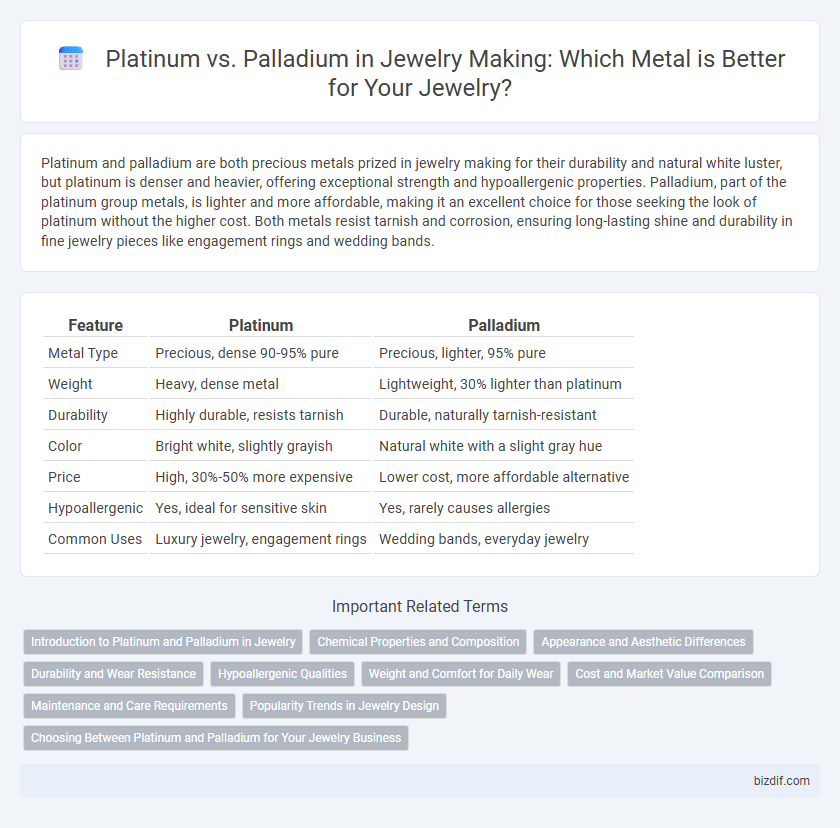Platinum and palladium are both precious metals prized in jewelry making for their durability and natural white luster, but platinum is denser and heavier, offering exceptional strength and hypoallergenic properties. Palladium, part of the platinum group metals, is lighter and more affordable, making it an excellent choice for those seeking the look of platinum without the higher cost. Both metals resist tarnish and corrosion, ensuring long-lasting shine and durability in fine jewelry pieces like engagement rings and wedding bands.
Table of Comparison
| Feature | Platinum | Palladium |
|---|---|---|
| Metal Type | Precious, dense 90-95% pure | Precious, lighter, 95% pure |
| Weight | Heavy, dense metal | Lightweight, 30% lighter than platinum |
| Durability | Highly durable, resists tarnish | Durable, naturally tarnish-resistant |
| Color | Bright white, slightly grayish | Natural white with a slight gray hue |
| Price | High, 30%-50% more expensive | Lower cost, more affordable alternative |
| Hypoallergenic | Yes, ideal for sensitive skin | Yes, rarely causes allergies |
| Common Uses | Luxury jewelry, engagement rings | Wedding bands, everyday jewelry |
Introduction to Platinum and Palladium in Jewelry
Platinum and palladium are both precious metals renowned for their durability and naturally white luster, making them popular choices in fine jewelry. Platinum is valued for its density and hypoallergenic properties, often used in high-end engagement rings and wedding bands, while palladium offers a lighter, more affordable alternative with similar resistance to tarnish and corrosion. Both metals belong to the platinum group, sharing exceptional strength, and resistance to wear, which ensures long-lasting, elegant jewelry pieces.
Chemical Properties and Composition
Platinum and palladium are both members of the platinum group metals, with platinum having an atomic number of 78 and palladium 46, influencing their density and malleability. Platinum has a higher melting point of 1,768degC compared to palladium's 1,555degC, making it more suitable for high-temperature applications in jewelry casting. Both metals resist oxidation and corrosion, but palladium is lighter and less dense, often used as an alloy to enhance white gold's durability and whiteness.
Appearance and Aesthetic Differences
Platinum offers a naturally white, lustrous sheen with a slightly grayish tint that deepens with wear, creating a rich, elegant appearance preferred for classic jewelry designs. Palladium displays a brighter white finish with a more subtle shine, maintaining its color without the need for rhodium plating, which makes it ideal for modern, minimalist styles. Both metals resist tarnish, but platinum's heavier weight and dense composition contribute to a more substantial, prestigious feel compared to palladium's lighter and more understated aesthetic.
Durability and Wear Resistance
Platinum offers exceptional durability with a dense atomic structure that resists wear, making it ideal for everyday jewelry like engagement rings. Palladium, while lighter and more affordable, exhibits a strong resistance to tarnish and scratches but may wear down faster under constant friction. Both metals provide excellent wear resistance, yet platinum's robustness outperforms palladium for long-lasting, heirloom-quality pieces.
Hypoallergenic Qualities
Platinum and palladium are both hypoallergenic metals favored in jewelry making for their minimal risk of causing allergic reactions. Platinum, with its dense and pure composition, is less likely to irritate sensitive skin compared to alloys that contain nickel. Palladium, a member of the platinum group metals, offers similar hypoallergenic benefits but is lighter and often used as a nickel-free alternative in fine jewelry.
Weight and Comfort for Daily Wear
Platinum jewelry is denser and heavier than palladium, providing a substantial feel that many associate with luxury, while palladium's lighter weight offers greater comfort for extended daily wear. Palladium's naturally hypoallergenic properties enhance wearability without compromising durability, making it ideal for sensitive skin. The choice between the two metals depends on personal preference for weight and comfort in everyday jewelry use.
Cost and Market Value Comparison
Platinum generally commands a higher market value than palladium due to its rarity and density, making it more expensive per ounce. While palladium is more affordable and has gained popularity in recent years, platinum's superior durability and historical prestige contribute to its premium cost. Jewelers often consider these factors when choosing between metals for investment-quality jewelry versus cost-effective, stylish pieces.
Maintenance and Care Requirements
Platinum requires regular polishing to maintain its lustrous finish and is highly resistant to tarnish, making it low-maintenance yet durable for daily wear. Palladium, a member of the platinum group metals, is naturally tarnish-resistant and needs less frequent cleaning, appealing to those seeking minimal upkeep. Both metals benefit from periodic professional inspections to ensure structural integrity and preserve their value over time.
Popularity Trends in Jewelry Design
Platinum and palladium both enjoy popularity in jewelry design, with platinum favored for its durability and hypoallergenic properties, making it a preferred choice for engagement rings and luxury pieces. Palladium's lightweight nature and affordability have increased its appeal among designers seeking modern, minimalist styles. Trends indicate a growing demand for palladium in contemporary collections, while platinum remains a timeless symbol of elegance and prestige.
Choosing Between Platinum and Palladium for Your Jewelry Business
Platinum and palladium both offer exceptional durability and hypoallergenic properties, essential for high-quality jewelry making. Platinum's density and natural white luster provide a luxurious finish, while palladium is lighter and often more cost-effective, appealing to budget-conscious customers. Selecting between these metals depends on balancing product weight, price point, and the desired market segment for your jewelry business.
Platinum vs palladium Infographic

 bizdif.com
bizdif.com